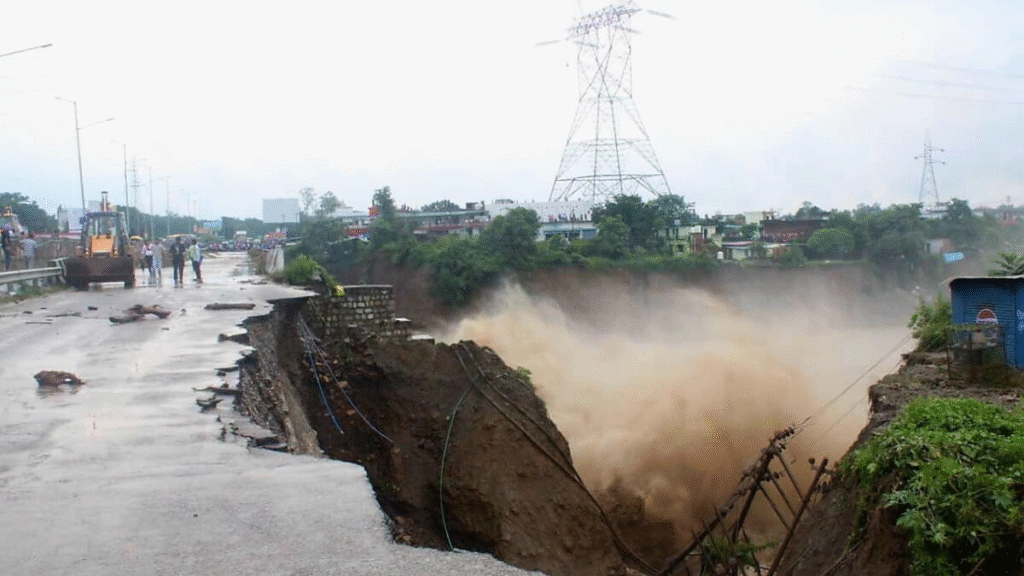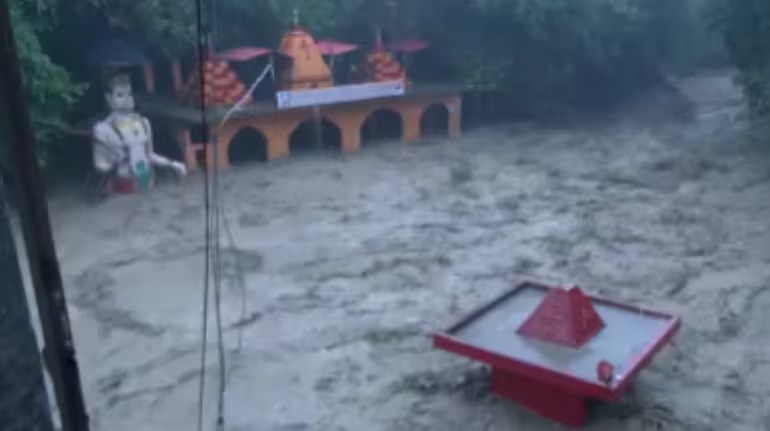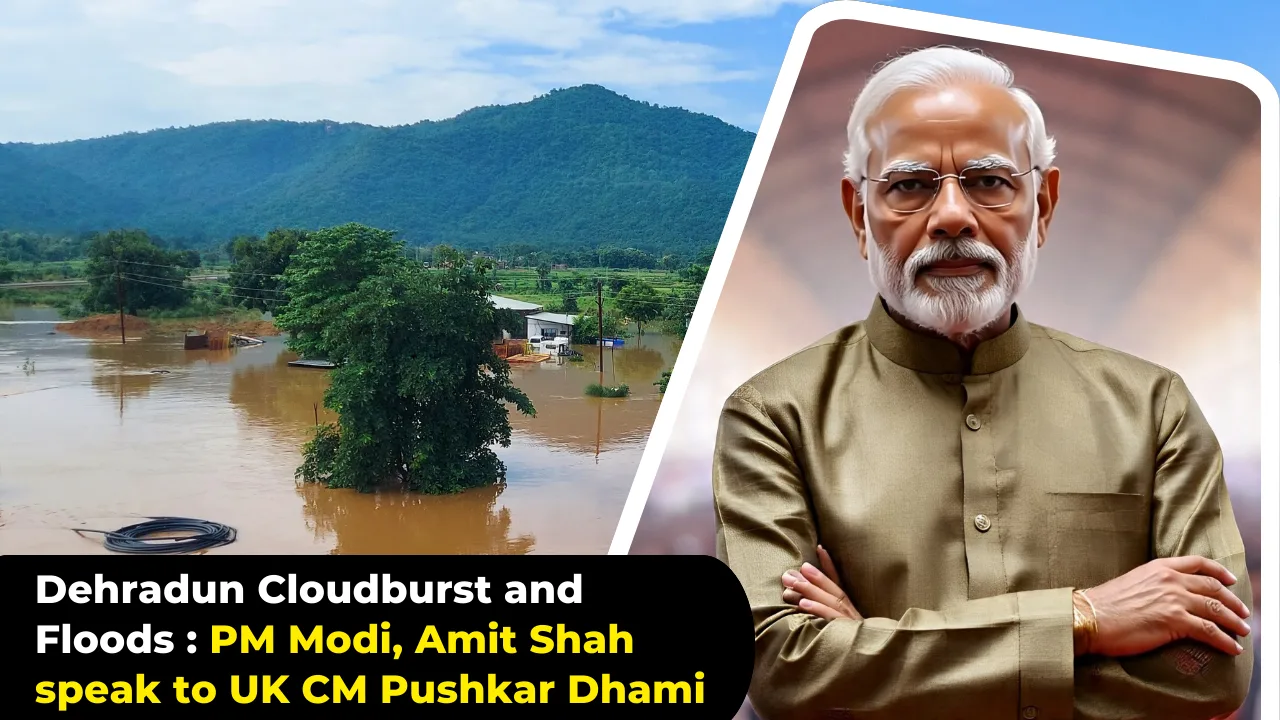Dehradun Cloudburst and Floods: A devastating cloudburst in the early hours of Monday has triggered deadly Dehradun district floods 2025, plunging the city into chaos and leaving a trail of destruction. As heavy overnight rain lashed the region, flash floods and landslides wreaked havoc, leading to the tragic loss of at least five lives.
The disaster has not only submerged residential areas and key infrastructure but has also seen the Chandrabhaga river in Rishikesh swell to dangerous levels, inundating parts of the city.
The severity of the situation has prompted a rapid response from the highest levels of government, with Prime Minister Narendra Modi and Home Minister Amit Shah personally speaking with Uttarakhand Chief Minister Pushkar Dhami to assure all possible central assistance.

This blog post delves into the specifics of the Dehradun district floods 2025, examining the causes, the immediate impact on the city, the government’s response, and the long road to recovery ahead.
The Anatomy of a Disaster: The Dehradun Cloudburst
The catastrophe began with a cloudburst, a meteorological phenomenon characterized by an intense downpour over a localized area. In the case of Dehradun floods 2025, the Sahastradhara area bore the brunt of this deluge. The sudden, immense volume of water overwhelmed the region’s streams and rivers, including the Tamsa river, which burst its banks and submerged the revered Tapkeshwar Mahadev temple.
The sheer force of the floodwaters was powerful enough to sweep away people, vehicles, and structures. Initial reports confirmed that at least five individuals were swept away in the torrent, highlighting the deadly speed and destructive power of flash floods. The chaos wasn’t limited to the city’s outskirts; even the well-planned IT Park area was not spared, with buildings and roads submerged, leaving residents and office workers stranded.
The Dehradun-Haridwar highway, a vital link, was also severely impacted, with a key bridge near Fun Valley collapsing, disrupting connectivity.

This event serves as a stark reminder of the vulnerability of even well-developed urban areas in mountainous regions to extreme weather phenomena. While cloudbursts are a known risk in the Himalayas, the intensity and location of this particular event have been especially destructive.
A Swollen Chandrabhaga Inundates Rishikesh
The ripple effect of the Dehradun cloudburst extended beyond the district’s borders, with the Chandrabhaga river in Rishikesh experiencing a massive surge in its water levels. Following the heavy rainfall, the river overflowed its banks, pushing muddy torrents onto the highway and into residential areas. This led to several vehicles getting stranded and prompted the State Disaster Response Force (SDRF) to conduct swift rescue operations, saving three people who were trapped in the river.
Read in Hindi: Uttarakhand Floods 2025 | उत्तरकाशी में बादल फटा: तबाही का खौफनाक मंजर और बचाव कार्य जारी
The flooding in Rishikesh is a significant concern, not only for the local population but also for the thousands of pilgrims and tourists who visit the holy city. The inundation of the highway and other key areas has created a logistical nightmare, further hampering relief efforts and travel in the region.
The High-Level Government Response
In a testament to the gravity of the situation, the central government has been actively involved in the relief efforts from the very beginning. Prime Minister Narendra Modi and Union Home Minister Amit Shah have both been in direct communication with Uttarakhand CM Pushkar Dhami.

This high-level engagement underscores a critical point: the national government views the disaster as a matter of significant concern, requiring a coordinated and robust response. According to a statement from the Chief Minister’s Office, both PM Modi and Amit Shah assured CM Dhami of “all possible assistance from the Centre.”
This includes the deployment of resources from the National Disaster Response Force (NDRF), which is working in tandem with the state’s SDRF and police teams on the ground.
The quick response and assurance of support are vital for several reasons:
- Boosts morale: It reassures the affected population that they are not alone and that the entire nation stands with them.
- Accelerates relief: It ensures that relief and rescue operations are not hampered by a lack of funds or resources.
- Fosters coordination: It creates a seamless flow of communication and resources between state and central agencies, leading to a more effective response.
CM Dhami has been on the ground, personally monitoring the situation and directing officials to ensure that no affected family is left without support. He stated, “The state government stands with every affected family,” and emphasized that teams are working “on a war footing.”
The Road to Recovery: Challenges and a Call to Action
The immediate aftermath of the Dehradun district floods 2025 presents a series of daunting challenges. The city faces significant infrastructure damage, including:

- Washed-out roads and bridges: This severely impacts connectivity and complicates rescue and relief efforts.
- Damaged commercial properties: Businesses in areas like Sahastradhara have been destroyed, causing economic hardship for many families.
- Waterlogged homes: Residents have been displaced and their homes damaged, requiring urgent shelter and assistance.
The government has already initiated recovery efforts, including the closure of schools to ensure the safety of students and the activation of the Incident Response System (IRS). An estimated 200 students were rescued from a waterlogged institute, a testament to the swift action of the SDRF.
Moving forward, long-term recovery will require a multi-faceted approach. This includes:
- Rebuilding infrastructure: Repairing roads, bridges, and other public facilities will be a top priority.
- Providing financial aid: The government will need to provide financial assistance to those who have lost their homes and livelihoods.
- Implementing preventive measures: A thorough review of urban planning, drainage systems, and early warning systems is essential to mitigate the impact of future disasters.
A Community United in the Face of Disaster
The Dehradun floods 2025 have been a tragic event, but they have also highlighted the resilience of the community and the swift, coordinated response from various government agencies. From the brave SDRF personnel rescuing trapped residents to the high-level assurances from the Prime Minister and Home Minister, the response has been a united effort to bring normalcy back to the region.
While the city faces a long and arduous path to recovery, the collective will to rebuild and support one another remains strong. It is a moment for introspection on climate change and urban planning in vulnerable areas.

















